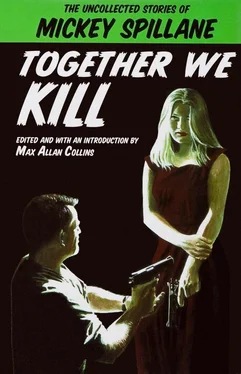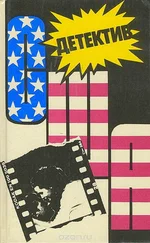Together We Kill:
The Uncollected Stories of Mickey Spillane
Together We Kill
an introduction
by Max Allan Collins
Mickey Spillane — the best-selling noir novelist of the Twentieth Century, the author of such seminal hard-boiled novels as I, the Jury (1948) and Kiss Me, Deadly (1952) — may well be a short story writer at heart. He cut his eyeteeth on the hard-boiled short fiction of Carroll John Daly and Fredric Brown, and honed his own craft in the pre-WWII comic book industry, writing short fiction “fillers” designed to satisfy certain postal regulations requiring text pieces. And though Spillane’s famous detective Mike Hammer has appeared rarely in short stories, the Mick has frequently shown his affection for — and dexterity at — the short-fiction form, through periodic publication of such pieces as appear in this book.
Spillane in particular wrote short stories (and articles) for macho men’s “mags” in the 1953–1960 period that his fans think of as the “drought” between novels (Kiss Me, Deadly in ’52 and The Deep in ’60). A number of these (often novellas) were collected in ’60s paperbacks published by Corgi in Great Britain and Signet in the United States — Mickey needed quick money to fund his ’62 film version of The Girl Hunters, in which he starred as Hammer — and most of the other stories were gathered in my 1984 Mysterious Press collection, Tomorrow I Die.
In the introduction to that book I mentioned that several other stories — anthologized but never in a Spillane-only book — might be collected on another day. That day — a day of the guns, as Mickey would say — has arrived.
I also mentioned, in the intro to Tomorrow I Die, that I was still searching for unanthologized Spillane stories. My friend Lynn Myers — a true Spillane aficionado and historian-made an important discovery, not long ago: “Together We Kill,” apparently the first of Spillane’s fiction appearances in Cavalier magazine, unseen and unread — and unknown, even by so-called Spillane experts like myself — since 1953. The story proved to be terrific, and its typically Spillane title — melodrama wrapped up in a personal pronoun — gave a fitting name to this book.
Two of Spillane’s best stories appear here; one of them, “Hot Cat,” a short novel, is also known as “The Flier,” and as such was the title story of a 1964 Great Britain paperback, never reprinted in the U.S.A. As published here, it contains an opening paragraph omitted from its publication in The Flier. “Hot Cat” reflects Mickey’s love of flying, as does his personal favorite, “The Affair with the Dragon Lady” (his last Cavalier story), a rare, non-mystery valentine to the pilots of WWII (a group that includes Spillane).
Surprisingly, Mickey never really wrote Mike Hammer short stories. A few short works — a script for a “pilot” film (“The Screen Test of Mike Hammer,” published in Tomorrow I Die ) and a two-person playlet on a 1954 10" album, Mickey Spillane’s Mike Hammer Story — almost qualify. And in recent years, Mickey has condensed his two latest Mike Hammer novels into short fiction form for Playboy (one of these, “The Killing Man,” won a Private Eye Writers of America “Shamus” for best short story).
This book contains the only ’50s vintage Hammer short story known to exist... and there’s a tale behind the tale, as well. “The Night I Died” was a radio play manuscript I found in a corner of Mickey’s office at his home in Murrell’s Inlet, South Carolina. Though the story was in script form, Mike Hammer’s distinctive voice-over made it possible to transcribe this typical Hammer yarn into short-fiction configuration... which I did, for the 1998 collection Mickey and I coedited, Private Eyes.
“I’ll Die Tomorrow” is another story Mickey wrote for Cavalier, a hitman tale that is one of his most overtly noir works. The two autobiographical short-shorts herein — “The Dread Chinatown Man” and “Toys for the Man-Child” — appeared in True in 1975, and pretty much bring to an end Mickey’s long run as a contributor to macho men’s magazines. “Hot Cat” had appeared in Saga in ’64; around ’62 Mickey had ceased contributing to Cavalier when its content shifted from blue-collar he-man subject matter — like sports cars and hunting — into pseudo- Playboy territory, with centerfolds and left-wing commentaries. /Mickey never cared much for Playboy, and it’s perhaps ironic that his most recent short stories have wound up there. Cavalier, by the way, makes a significant on-screen appearance in Spillane’s film, “The Girl Hunters.”
The most controversial Spillane story of all, “The Veiled Woman,” is included here, as much for historical interest and completist purposes as any literary value. Spillane’s only science-fiction work — at least until the revival of Mike Danger as a mid-’90s comic book with a futuristic setting — “The Veiled Woman” appeared in the second issue of Fantastic, to much fanfare. But did Mickey really write it?
Rumors — some of them spiteful ones by the likes of the late Michael Avallone, a gifted but troubled writer who envied Spillane’s success — have abounded over the years that some of Mickey’s work has been ghosted. Author Stephen Marlowe was often cited as the author of several 60s Spillane novels. Mickey denies this vehemently, and Marlowe in an interview for my documentary, “Mike Hammer’s Mickey Spillane” (1999) — is just as adamant that he never ghosted anything for Mike Hammer’s creator... though Marlowe did admit his own work owed Spillane a heavy debt.
The rumored author of “The Veiled Woman” is Howard Browne, a fine novelist and screenwriter and the author of the Paul Pine private eye novels, which are much admired. In the early ’50s, Browne was the editor of Fantastic when Spillane’s story was scheduled to appear. Browne had purchased an outline for the story from Mickey and advertised the tale heavily, at a time when Spillane’s name carried the weight of Stephen King or Dean Koontz... at least.
But Mickey missed his deadline, and Browne — working from Spillane’s proposal — quickly wrote a Spillane pastiche. When it appeared, Mickey was furious... but Browne explained the situation — that the young magazine had hyped the Spillane appearance and simply had to deliver to its readers — and Mickey withdrew his complaints.
I knew Browne fairly well, and spoke to him about this a number of times; and I know his tellings of the above varied as to detail. But this is how Browne explained “The Veiled Woman” to me, and it gibes with Mickey’s explanation. So it appears in this, the companion volume to Tomorrow I Die, in an effort to complete the collected Spillane short fiction... and may be fairly viewed as a collaboration between two terrific writers, if the least of the tales in this book by some distance.
Is this, then, the final Spillane collection? Possibly not. Is this everything? Definitely not. My friend Lynn Myers and I are attempting to locate Spillane’s short-shorts for the comic book market, and are already well on our way; also remaining are wonderful Spillane articles on moonshine hot rodders, race car driving, deep-sea fishing and the circus, among others. We hope to gather these into a final volume, probably entitled Byline: Mickey Spillane.
And who knows what other Spillane gems may turn up, unexpectedly, like “Together We Kill”? Speaking of which, you’re in for a real treat, reading that yarn, and its brothers, in the pages ahead, littered as they are with fliers, hitmen, private eyes and Mickey Spillane himself.
Читать дальше





![Микки Спиллейн - Death of the Too-Cute Prostitute [= Man Alone]](/books/437201/mikki-spillejn-death-of-the-too-thumb.webp)